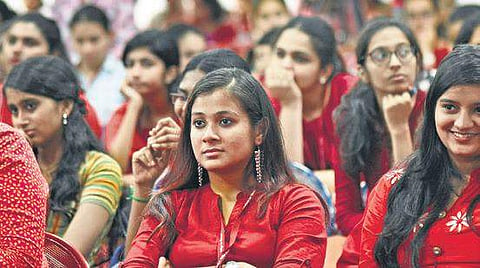

CHENNAI: Reporting emergencies can be taxing and complex in more ways than one. This issue was captured in the panel discussion that took place as part of MOP Vaishnav College’s two-day Media Conclave 2019 on Responsible Journalism on Friday. The conclave was inaugurated with an address by Justice CK Prasad, chairman of the Press Council of India, and saw keen participation from students from different colleges in the city.
The panel discussion on ‘Reporting emergencies responsibly’ was moderated by RK Radhakrishnan, associate editor, Frontline. A panel including D Krishnan, former photo editor, The Hindu; Maya Sharma, executive editor (South), NDTV Bengaluru, and CS Koteeswaran, assistant editor, Politics, DT Next narrated how they respond to reporting an emergency — the challenges, moral complexities and maintaining a balance between objectivity and empathy.
“Emergencies are not a time to guess and speculate,” said Maya. “You must only put out facts. You should not put out things you’re not sure about because it can create panic. I would say it is better to err on the side of less information rather than putting out false information. In times of emergencies, a journalist is also performing a social service so it is essential to put out things that are of practical use to people such as helplines and keeping people informed of where there is help required.”
Maya emphasised on the challenges that she faced as a woman on the field — be it the basic facilities like not having access to food, water or no access to a toilet for hours on end. She said it was imperative to not get emotionally affected or overwhelmed by the enormity of a tragedy too. She recounted how emotionally draining it was to cover something like the tsunami that hit Chennai in 2004.
RK Radhakrishnan spoke of the harrowing and haunting experience while covering the tsunami. “We don’t forget a tragedy,” he said. “We remember exactly where we were and what we were doing that day. I remember accompanying the coast guard and once I came back, I could not type a word for three hours because of the surge of grief that I was struck with.”
Krishnan spoke about the importance of visuals while reporting emergencies and how one should be responsible when it comes to putting out images in the media. Through his presentation, he showed instances where editorial calls were taken keeping in mind that pictures of bloodshed and dead bodies should be avoided on the front page and how in two different instances this was used — an incident when a man was attacked after getting too close to a tiger in a zoo and during the Zaveri bazaar blasts in Mumbai.
“For photographers, we always shoot first and ask questions later. We are the eyes of the people so we must show what is happening there. If the emotion happens, then you can capture it. But if there is nothing like that, it should not be created,” he said.
Koteeswaran spoke of the ills of sensationalism. “When reporting emergencies, it is important for a journalist to cut the emotion and respond to the situation,” he said. “It is important to report what is happening on the ground, give people information that they should know and report what you see and not create drama. Remember that in an emergency, everyone is a stakeholder so you talk to people other than just officials.”